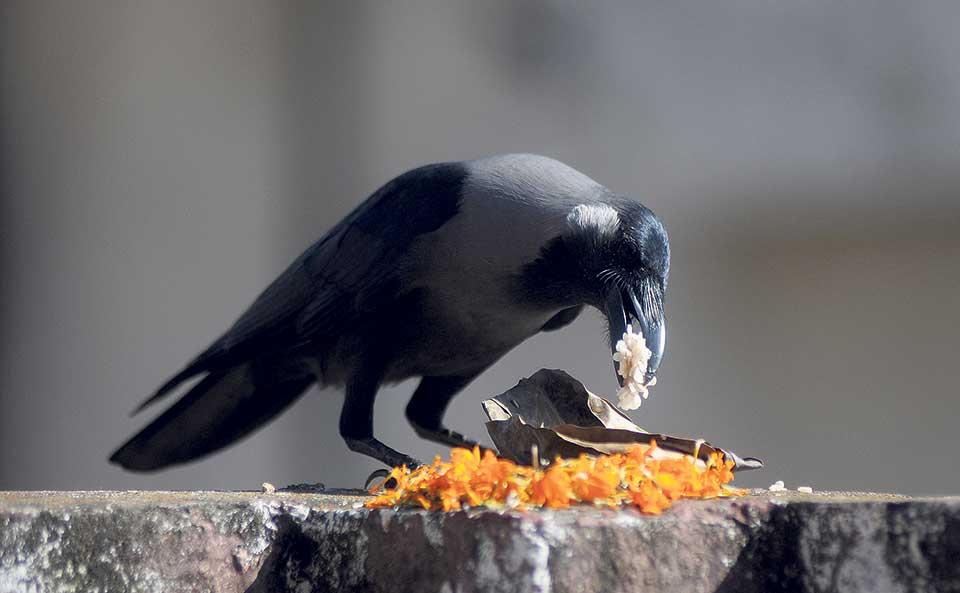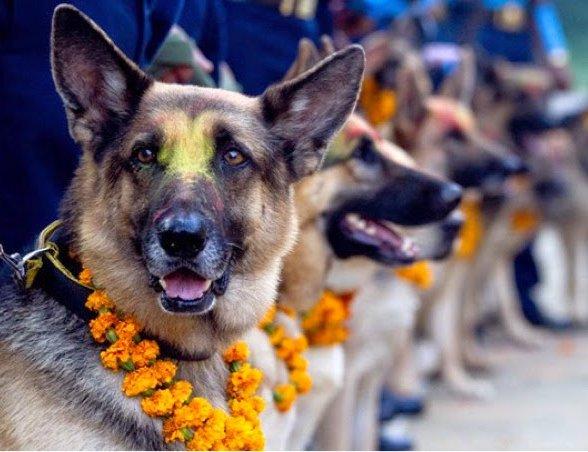
The story of Tihar: Celebrating the Bond between siblings
The story of Tihar: Celebrating the Bonds between siblings
The colorful festival of Tihar is a five-day Hindu Festival celebrated all over Nepal as well as a few states in India, such as Sikkim and West Bengal. Also known as Deepawali or Yamapanchak, Tihar celebrates different aspects of nature: animals, colors, light, people, and their kinship.
However, Nepal is a multilingual, multicultural and multiethnic country, and people following any religion are free to part take in this bright and beautiful festival.
Similar to the Indian festival of Diwali, Tihar is also celebrated with lights and different colors. The faces of almost all homes are decorated as a bride during the festival of Tihar with lights, flowers, and other decorations.
However, unlike Diwali, Tihar is unique and calls for worshipping living creatures namely crows, dogs, cows, and ox. Generally, Tihar falls in the month of Kartik (October/November) according to the Nepali calendar.
History of Tihar
There have been many stories about how Tihar started.
As one of the stories goes, once a girl named Yamuna had a very ill brother. And one day when Yamuna was worshipping for the health of her brother, Yamaraj, the Hindu god of death appeared at her house to take the soul of her brother.
However, before Yama could take her brother’s soul, Yamuna requested him to take part in the Puja (worship).
Impressed with Yamuna’s worship, Yamaraj granted her a boon. In return, Yamuna asked for a long and healthy life for her sick brother. And thus marked the beginning of Tihar to celebrate the relationship between brother and sister.
Likewise, there is a slightly different version of this story in Kirant history.
In this story, long ago a Kiranti King by the name of Bali Hang was mortally ill. His sister, Jamuna was with him taking care of her.
And when Yamaraj came for the soul of King Bali, Jamuna asked Yama to wait until she finished worshipping her brother.
The God of Death agreed to do so. However, while she was worshipping, Jamuna set up some conditions. Her conditions were until the Tika on Bali’s head faded away until the Makhamali (globe amaranth) garland around his neck wilted, the oil smeared on her brother's body dried, or the barrier she made with water around her brother evaporated, Yama could not take her brother.
So, each year on that very day, Yama would send some of his messengers to check on the Makhamali flowers. But the flowers would not wilt. Impressed by this, Yama granted Bali a long and healthy life.
Henceforth, for this reason, sisters worship their brothers in Tihar.
As another story goes, Yama and Yamuna were brother and sister. Yama, being the God of Death was busy all the time, as a result, Yamuna was unable to meet her brother.
So, in order to meet her brother she sent a message to her brother using a crow, a dog, and a cow. Still, Yama could not spare time to meet Yamuna.
Therefore, on the fifth day, Yamuna herself went to meet Yama. Upon meeting Yama, she put a five-colored Tika on Yama’s forehead. Thus marking the celebration of Bhai Tika and Tihar as a whole.
How it is celebrated…
As the second biggest festival in the Nepali Calendar, the Government of Nepal normally provides a three-day nationwide holiday.
However, the festival spans five days and might overlap or extend depending on the Bikram Sambat Calendar. Anyways here’s how we celebrate Tihar
1. Kaag (Crow) Tihar
It marks the beginning of Tihar.
As the Crows and Ravens are considered the messenger of the death god Yamaraj by the Hindus, they pray to the crow in hopes of pleasing them and warding off death and grief.

Praying to crows include offerings in the form of grains, seeds, and sweets which are placed on roofs or out on the streets.
2. Kukur (Dog) Tihar
On this day, all dogs whether domesticated or strays will be worshipped for their loyalty.
The worship is done by putting a Tika on the dog’s forehead, a garland around their neck, and treating them with delicacies.

The relationship between man and dog has also been elaborated in the ancient Mahabharata where Yudhishthira one of the Pandavas refuses to enter heaven without the faithful dog which had followed him on his way. The dog later reveals himself as God Yama.
Likewise, Hindus also believe that Yamaraj has two dogs with four eyes each who watch over the gates of Hell.
3. Gai (Cow) Tihar & Lakshmi Puja
On the morning of the third day of Tihar, Cows are worshipped and celebrated.
Cows are considered sacred by the Hindus and are the vahana(vehicle) of the goddess of wealth Laxmi.
Similarly, as an agricultural country, Cows have shaped themselves as an indispensable animal in Nepal.
We use their milk to make cheese, ghee, paneer, and other dairy delicacies. Even cow urine is considered to be holy and full of health benefits while their dung is used as fertilizers and Biogas.
So, on this day Nepali Hindus show gratitude towards Cows by putting garlands and tika on them while also feeding them delicacies.
And as the day comes to an end you’ll be delighted to see groups of girls and boys of all ages going around their locality, singing and dancing in a tradition known as Bhailo.
And in return for their entertainment, they are traditionally rewarded with money and sweets (namely Sel Roti).
However, the girls and boys are not rewarded if Lakshmi Puja has not been completed yet. So, they can’t rush it either.
To welcome the goddess Lakshmi into their homes, people clean whole yards and houses.
Likewise, doors and windows are decorated with garlands made of Marigolds, and Diyos (oil lamps made of clay) are lit throughout the home so as to persuade the goddess of wealth to visit their homes and bless them.
A special Lakshmi Puja takes place with all the family members present. There they pray to Lakshmi for wealth and prosperity.
4. Goru (Ox)/ Govardhan Puja and Maha Puja
Oxen are worshipped and celebrated on the fourth day of Tihar where they enjoy special treats. The oxen still provide manual labor in many parts of Nepal which is very significant for an agricultural country like Nepal.
And as dusk hits again, a group of young boys and girls go around singing and dancing Deusi and like Bhalio, people present the group with cash and sweets.
Similarly, on this day Vaishnav Hindus also perform Govardhan Puja, where a pile of Cow Dung is used as a representative of the holy Govardhan Mountain. As the story behind Govardhan Puja goes, herders living close to Govardhan used to pray to Lord Indra the God of Rain. One day Krishna suggested that there was no need to pray to any specific god rather than Purna Parmatma (The Absolute Divine).
On this advice, the herders stopped praying to Indra. Angered by this Indra caused heavy downpours around Govardhan Hill. In order to save the villagers from the rain and storm, Lord Krishna lifted the entire Govardhan Hill providing the villager's shelter under it. Henceforth, this day is celebrated as Govardhan Puja.
Coincidentally, this day also happens to be the first year according to the Nepal Sambat calendar and is celebrated as Mha Puja by the ethnic Newar Community.
5. Bhai Tika
The final, most important, and most exciting day of Tihar, on Bhai Tika brothers and sisters worship each other, strengthening their bond. Sisters mark a barrier of holy water and blessed oil around the brothers, circling them several times. The barrier is meant to keep away death and evil spirits.
After that the sisters apply oil to their, and put a Tika on their forehead, consisting of seven colors, and a Makhamali Garland around their neck. The brother then also put Tika on the sister’s forehead. After that, the brothers place their foreheads on their sister's feet signifying, love and devotion.
The brothers are also presented with sweets, confectionaries, and a variety of cooked food. In return, the sisters receive gifts in form of cash, clothing, etc. During Tihar, one can find boxes filled with nuts and sweets in shops, which are also presented by sisters to their brothers.
As for those who neither have brothers nor sisters, they visit Ranipokhari Temple in Kathmandu to put or receive Tika. Hindus believe that the forehead should not be empty on this day.
Tihar 2022
For the year 2022, Tihar spans from Saturday, October 2022 to Thursday, October 27. If you’re planning to visit Nepal during Tihar, you’ll be greeted with a colorful display of lights, colors, and traditions.
If you’re planning to enjoy a trek during Tihar, you’ll be enjoying a bonus of festivities and culture along with your peaceful dose of nature. For an experience like no other, you can contact us at +977********** or *****@****.com.
